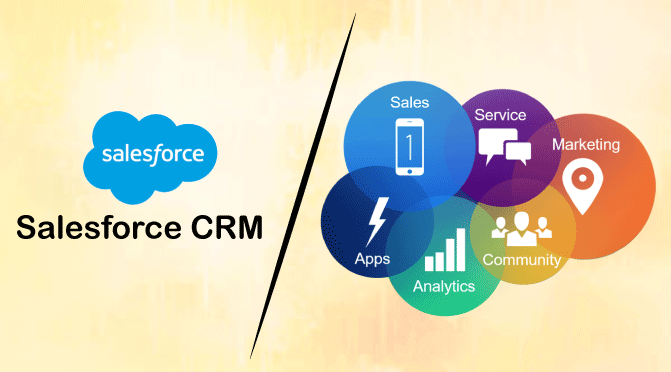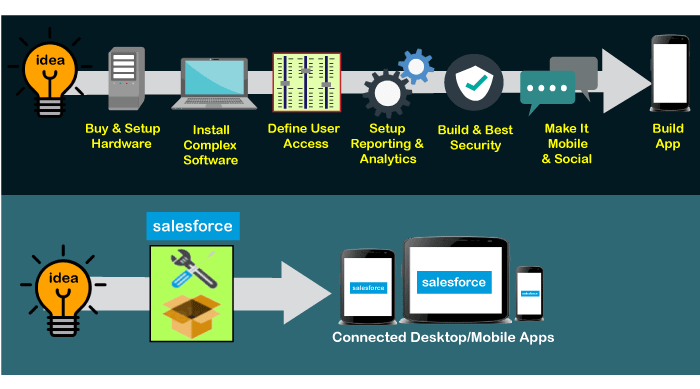Salesforce CRMSalesforce is the World's leading CRM platform, enabling businesses to connect the customer efficiently, anytime, anywhere. To better understand the Salesforce, we first need to understand the CRM, its functionality, aspects, and why to choose salesforce CRM. In this topic, we will understand all these basic concepts of CRM. 
What is CRM?CRM stands for "Customer Relationship Management." It is a software used to store all customer-related details, such as Customer Name, Phone Number, Email Address, etc. It is also used to store all the records of the customer activities done for a particular product or business. Every business needs a tool or software that can collect, store, and manage all the customer-related information to focus on the leads and sales. A CRM system is a software that tracks the progress of any sales process. It also tracks all the customer details, complaints, emails, follow-ups done with customers, customer agents' conversations, etc. The CRM also monitors the duplication of any case. There are various CRM software available in the market, such as Salesforce.com, HubSpot CRM, Microsoft Dynamic, Freshsales, Pipedrive, Insightly, Zoho CRM, SAP CRM, etc. Each software has its features and benefits, but among all of them, Salesforce.com is the leading CRM software. Features of CRMBelow are the main features that a CRM software contains:
Aspects of Customer Relationship ManagementThere are mainly three aspects of any CRM system: 1. RetainFor any organization, it is crucial to maintain a good customer relationship with their clients or customers. If a customer is happy with the services, he will retail for a long time. For the continuous growth of any organization, acquiring new customers and retaining the old customers is mandatory. Below are three main reasons for which any customer leaves your service:
So, it is one of the crucial aspects of the customer relationship. 2. Acquire:Customer acquisition is another important aspect of the growth of any organization. Every company wants a huge number of customers to increase their popularity in the market. A large number of customers can bring the leads easily and help to beat the competitors. And any company never wants to lose such a customer because it is complicated to bring the customer back and maintain the same belief to compete. CRM helps to acquire new customers with good deals and sales. With the proper follow-up and good communication with the customers, any company can easily get new customers for their business. 3. Extend:After acquiring new customers and retaining the old customers, the next aspect of the CRM is the business extension. So how a CRM can help a business to extend the business value to its client? For this, any business can reach to its loyal customers for any new deal, as they will be the confirm buyer of that new deal. When any cosmetic brand wants to launch a new product, they reach out to some loyal customers first rather than directly launching it to the market. They know that they would surely buy the product and give crucial feedback for the product quality. With the help of the CRM tool, any company can easily identify such customers. Types of CRM SystemsCRM systems are mainly of two types, which are given below: 1. On-premise/Traditional System (Siebel)On-premise or traditional systems are those systems for which any company would have to install the server, hardware, and software to work with the CRM system. The main disadvantage of an on-premise system is that it needs a lot of time, effort, and money to install and start working on it. For on-premise CRM systems, the organization has to purchase the license of the software before installing it. If the organization has an acceptable security policy, then it is also the right choice. Still, the vendor does not have any responsibility for any flawless operation of the system after implementing the system. 2. On-demand/Cloud-based System (SFDC)The other CRM system type is a cloud-based system or SFDC(Salesforce.com), for which we don't need to install anything. Only we need a system or laptop, internet, and saleforce.com licenses, and just by signing up, we can start working on the CRM. Any organization needs to purchase the salesforce.com licenses because servers, networks, databases and infrastructure are all maintained by Salesforce. In a cloud-based system, the data is stored on the vendor's side, and they take all the responsibility for the system's seamless operation. The only main requirement is the high-speed internet connection. There are other cloud-based applications available today, such as google apps, cisco, Citrix etc. Why Use Salesforce CRM?Salesforce is the World's leading cloud-based CRM software. Being for a long year in the market, it provides comprehensive and most innovative CRM solutions. It is highly scalable and customizable, and it is also able to solve all the business requirements. The below diagram shows the difference between the legacy CRM platform and Salesforce CRM platform: 
Below are some reasons to choose the Salesforce CRM software:
Next TopicSalesforce Architecture
|
 For Videos Join Our Youtube Channel: Join Now
For Videos Join Our Youtube Channel: Join Now
Feedback
- Send your Feedback to [email protected]
Help Others, Please Share










